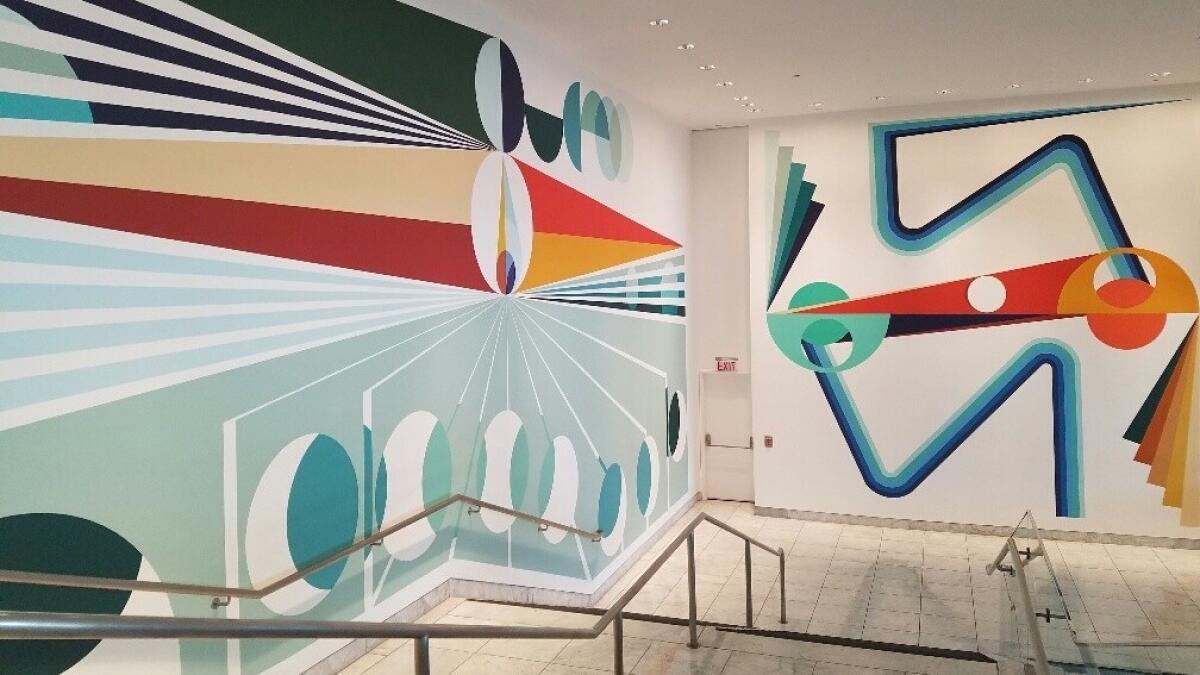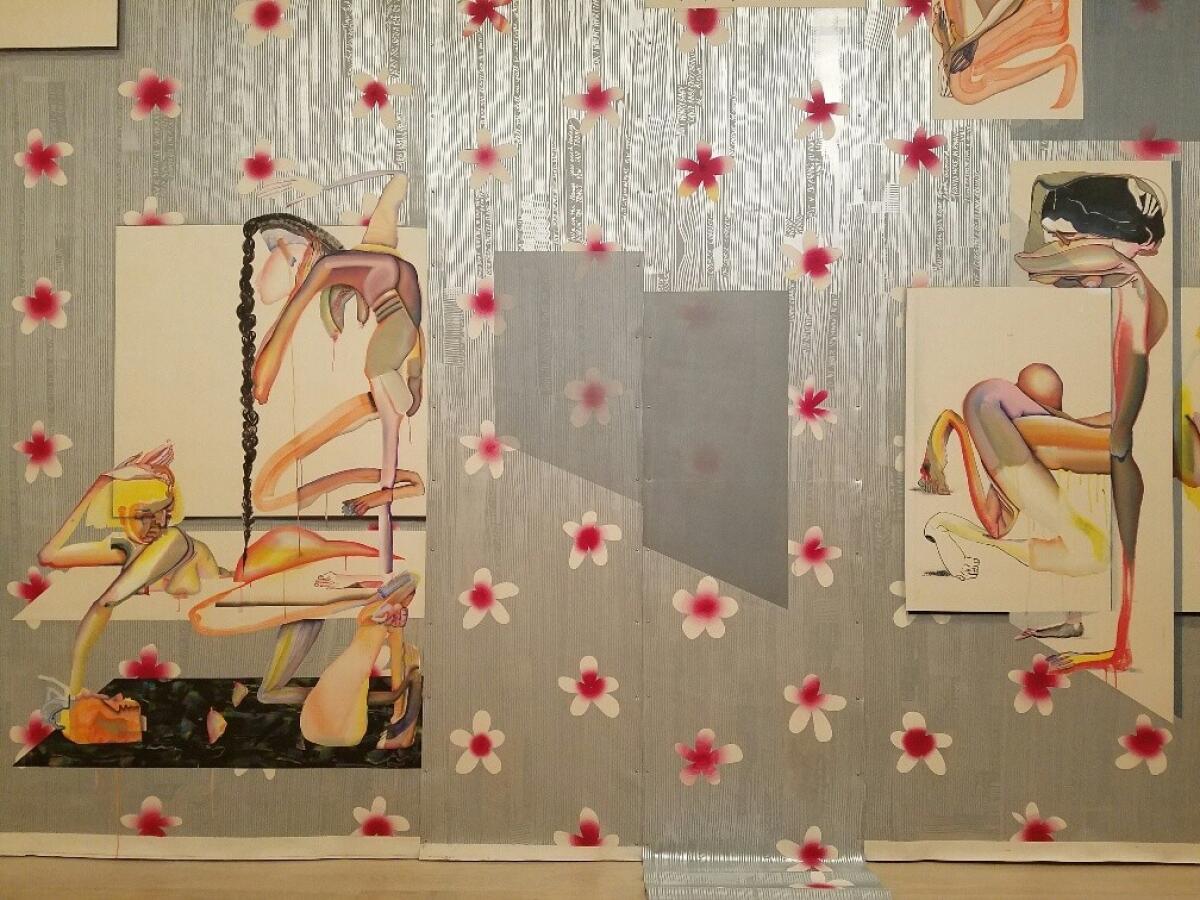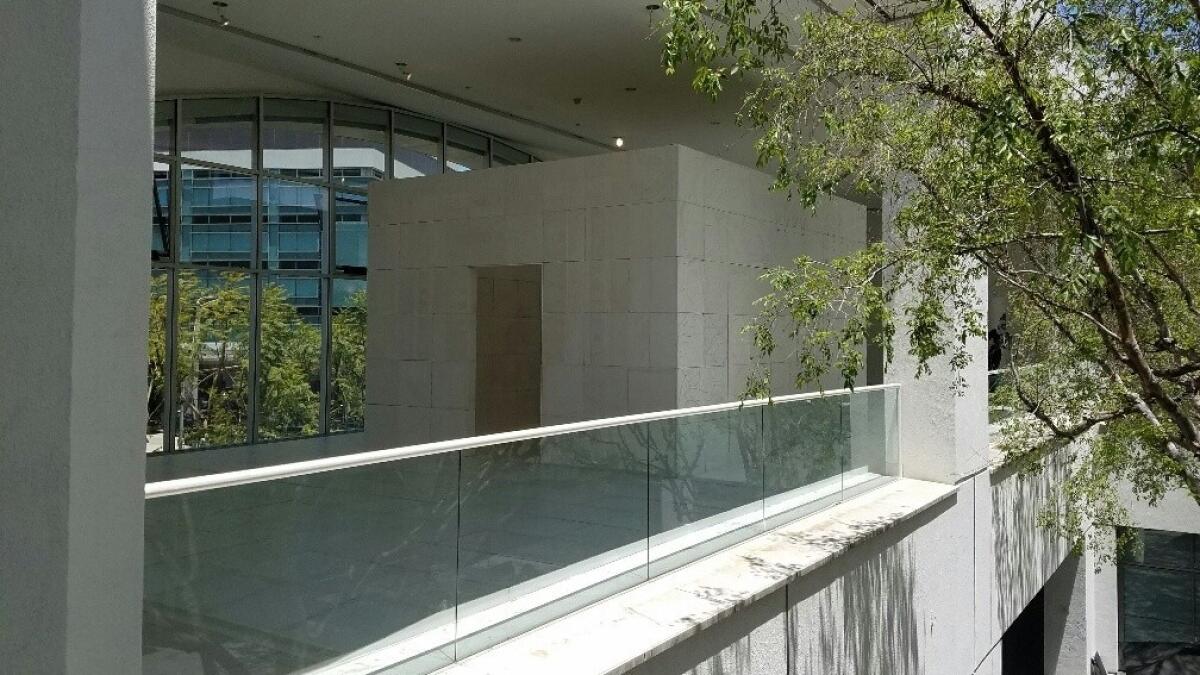Review: ‘Made in L.A. 2018’: Why the Hammer biennial is the right show for disturbing times
- Share via
The UCLA Hammer Museum’s much-anticipated biennial survey of new art produced in the city has just opened its fourth iteration. “Made in L.A. 2018” is the best one yet.
Part of the reason comes from simple, dramatic contrast. Since the show’s last outing in 2016, American society has been plunged into a period of destructive nastiness and malice. Art is inherently its opposite.
Artists have been responding. These 33 — up from 26 last time — were chosen with a keen attention to the resonance of their work within our socially disturbed time. Rather than art with partisan political agendas, Hammer curators Anne Ellegood and Erin Christovale have chosen smart work that, for the most part, feels acutely attuned to our beleaguered moment.
Emblematic is the big mural that wraps the stairwell at the museum’s front entry. At first look, you might not notice how.
In a palette of breezy pastels and tertiary hues, Eamon Ore-Giron painted hard-edge, geometric shapes that seem to fuse landscape elements represented as natural, industrial and schematic. In one lovely mural passage, a precision sequence of disks that evokes factory mass-production within a diagrammatic modern setting also conjures the phases of the moon.
Muralism has a long and venerable history in Los Angeles, home to landmark examples from the 1930s by David Alfaro Siqueiros and José Clemente Orozco. (The latter’s fiery “Prometheus” at Pomona College, an explosive burst of Expressionist fervor, is the first modern fresco in the United States.) Mexican muralism banished tasteful public decorum for blunt social agitation, essential to its Great Depression era.
Ore-Giron’s impressive mural interrupts that venerable tradition, responding to its public purpose and commitment in a novel way. The sleek formal rhythms of the Hammer mural are neither monolithic nor combative. Instead, they look to South America and Concrete art, with its cross-fertilization of imported European and indigenous modernisms. The forms draw on diverse pictorial legacies — say, a Uruguayan abstractionist like Joaquín Torres-Garcia and a Swiss one like Max Bill or a Russian like El Lissitzky.

Apparent influences also include commercial graphic design, the flat and patterned color of Peruvian painter (and occasional muralist) Josué Sánchez Cerron and the aural syncopation of folk and popular music. Right now, in the face of America’s reactionary narrow-mindedness, the work’s insistent cross-cultural heterogeneity feels joyfully subversive.
One response to a divisive power that clamors for building walls is to refuse by orchestrating artistic border crossings. The refined comeliness of Ore-Giron’s painting is one seductive method.
Narrative is another. Daniel Joseph Martinez traveled the length of the old Berlin Wall, which once kept Soviet-dominated East Germans from emigrating to democratic West Germany. He photographed himself at 80 spots holding aloft processional banners adorned with the face of Ulrike Meinhof, the Red Army Faction militant, shown at different stages of life — schoolgirl, ingénue, slain terrorist.
Martinez’s large-scale photographs are printed in luxurious silvery grays, nodding toward Gerhard Richter’s great 1988 painting cycle on the brutal Baader-Meinhof gang, as the RAF was also known. The Berlin Wall is long gone, but the indelible memory of the cruelty and persecution that it represented and enforced inevitably invokes the Trump administration’s incessant mantra of building a border wall between Mexico and the United States.
Martinez, who is Mexican American, has fashioned a Meinhof processional placard that recalls Catholic saint-banners, which derive from the military standards once carried into battle. Rather than triumphant, these photographs seem to propose that cruel division only serves to create martyrs.
Ore-Giron’s abstract painting and Martinez’s representational photographs occupy very different points on the show’s broad spectrum, but both refer back to the alarming social context to which the 2018 biennial is attuned. The only political position staked out is for commitment to deep cultural awareness — to acknowledging that artists are citizens too.
As always, the biennial emphasizes emerging and established but often lesser-known artists. These 33 range in age from 29 to 97 — the youngest (textile artist Diedrick Brackens) born in the immediate aftermath of the Reagan Revolution’s rightward jolt, the oldest (painter Luchita Hurtado) in the wake of the blistering brutalities of the First World War. Just five were born in Los Angeles, while eight are foreign-born. Urbanism’s vigorous cosmopolitanism stands front and center.
Video installations are prominent (there are nine), partly reflecting the easy accessibility now of inexpensive digital equipment. Subjects and formats could not be more diverse.
Among the strongest are Gelare Khoshgozaran’s quasi-documentary rumination on the strange, pseudo-Middle East towns erected in the California desert as test sites for U.S. military maneuvers; Neha Choksi’s achingly poetic, four-channel lamentation for the ongoing, perhaps irreversible degradation of Mother Earth (and a yearning to escape it); and, a wicked satire of self-improvement rituals for women who, in Freud’s foolish but pervasive misconception, are inherently lacking, by the team of Jade Gordon and Megan Whitmarsh.

Among the elegiac “Found Fragments” of lost life in James Benning’s installation is a ravishing, wall-projected video image of a sun-dappled forest, shot after a devastating recent wildfire. The landscape image, almost completely still, becomes a nearly abstract meditation on life-cycles and the mutability of fearsome tragedy and exquisite beauty.
Dance is seamlessly integrated into a line of six wall-mounted flat-screen video monitors by choreographer Flora Wiegmann. A virtual mural of shifting viewpoints, it exploits camera-work as bodily movement matching that of the depicted dancers. The two-dimensional screens compose a visual field corresponding to the amorphous white space through which the dancers move. All that is solid melts into an aesthetic sensation of pixilation.
Including Ore-Giron, half a dozen compelling painters are here. The complex, hands-on demands of painting perhaps stand as an indicator of a continuing reaction to today’s gauzy, enveloping digital ether.
John Houck began as a photographer, but now he is composing abstractions in which camerawork and painting masquerade as one another. The illusions in two-dimensional imagery are contradicted by flat surfaces that he’s folded, spindled and otherwise mutilated.
Similarly, several of Linda Stark’s textured relief paintings fuse female body parts and floral motifs within a physically mottled surface that looks like synthetic skin. A witty self-portrait focuses just above watery eyes onto her forehead, its “third eye” a picture of her cat inside a pink aura. No iconic pussy hat is shown, but as an image of wisdom implanted squarely in the forehead of a deity, the marvelously eccentric picture is a delight.
Seven lovely Surrealist landscape paintings from the 1970s by Hurtado seem informed by outer-space exploration. A circle of cloud-filled sky surrounded by voluptuous brown hills inverts the famous Apollo 17 photograph of Earth as a “big blue marble” floating through space. Here, it’s a void in the Earth that becomes an erotically suggestive spatial atmosphere.
A charming grunge imbues Celeste Dupuy-Spencer’s clotted pictures — a toppled Confederate statue crumpled like a corpse; a crude man anxiously reading a love letter; smokers indulging their simple, deadly pleasure while idling in a car parked in a trash-filled alley; and, a tightly clustered crowd drowning in a turbulent sea, unable to grasp a nearby lifeline, its arabesque almost decoratively baroque. The quirky paintings, touchingly civilized, are a gentle but firm avowal of humanity during extraordinarily trying times.

Finally, Christina Quarles paints trompe l’oeil paintings onto flower-bedecked “wallpaper” that she has also made, interrupting domestic space with knockout images of nude women entwined with their own and each other’s bodies, pushing against physical norms. Barely out of art school, she hasn’t shown much in L.A., so Quarles ranks as perhaps the biennial’s most exciting discovery.
Also impressive is Lauren Halsey’s “The Crenshaw District Hieroglyph Project (Prototype Architecture),” an imposing square room built of faux-marble walls cobbled together from ordinary gypsum, cardboard and off-white acrylic paint. In this white cube, humility equals grandeur.
As with Halsey’s current fine installation downtown at the Museum of Contemporary Art, which spins off the Classical motif of Plato’s Cave, this piece also looks to an ancient source — the Egyptian form of a cenotaph, or empty tomb. The list etched into interior walls includes Trayvon Martin, Freddie Gray, Sandra Bland and Philando Castile, plus dozens of unfamiliar names. A war memorial for 90 bodies buried elsewhere, the monument gathers shades.
At the other end of the spectrum, grim humor marks Charles Long’s installation, titled “paradigm lost,” which mixes sculpture and painting. Clusters of tree stumps appear both petrified and phallic. They are cleverly infused with sly visual references to a Surrealist and Expressionist pantheon of male artists — Munch’s face screams, Dali’s watches droop, Brancusi’s torso is another stump, Giacometti’s lopsided chariot would only run in circles. Within Long’s ruined art-forest, nature and culture pass into history.
It’s a sobering sight, until an odd and pleasant realization arises: One-third of the artists in the splendid “Made in L.A. 2018” are men, two-thirds are women. Not so long ago, a ratio of women far outnumbering men in a survey exhibition would have been a topic of stunned and enthusiastic comment.
Now it’s just a number. Women have long outnumbered men in the artist ranks, but institutions have been a drag on reality. Progress has finally been made! A quiet revolution has happened, with its own profound resonance amid today’s social strife.
♦ ♦ ♦ ♦ ♦ ♦ ♦ ♦ ♦ ♦
‘Made in L.A. 2018’
Where: UCLA Hammer Museum, 10899 Wilshire Blvd., Westwood
When: Through Sept. 2; closed Mondays
Information: (310) 443-7000, www.hammer.ucla.edu

christopher.knight@latimes.com
Twitter: @KnightLAT
MORE ART:
Iranian art at LACMA: The past wrestles with the present
A Native artist finds his place at the Autry
A preview of the future home of Orange County Museum of Art
More to Read
The biggest entertainment stories
Get our big stories about Hollywood, film, television, music, arts, culture and more right in your inbox as soon as they publish.
You may occasionally receive promotional content from the Los Angeles Times.











